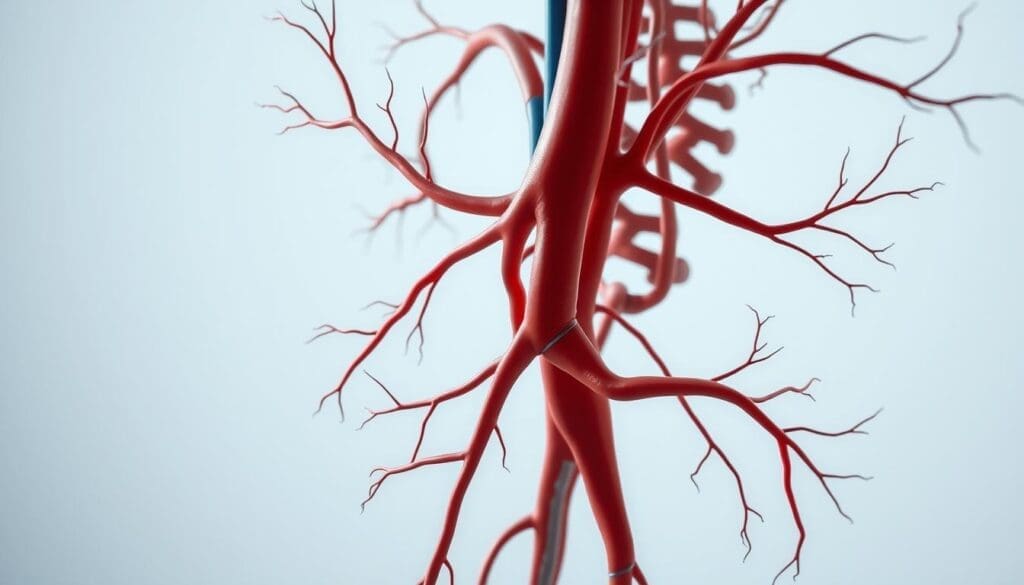Last Updated on November 25, 2025 by Ugurkan Demir

Arterial pressure is the force blood puts on artery walls. It’s key to our health. It’s measured in mmHg, showing the pressure in arteries as blood moves.Learn what is arterial pressure and how your body regulates it to keep your circulatory system balanced.
At Liv Hospital, we know keeping blood pressure healthy is important. It should be under 120/80 mmHg. The body has special ways to keep blood pressure right, even when things change around us.
Regulation of blood pressure is key to avoiding heart diseases. We’ll look into how the body keeps this balance and why it matters for our health.

Arterial pressure, or blood pressure, is key to understanding how our heart and blood vessels work. It shows how well our cardiovascular system is doing. Doctors watch it closely because it can tell them about health problems.
Several things affect arterial pressure. Cardiac output is how much blood the heart pumps each minute. Systemic vascular resistance is how hard it is for blood to flow through the body. Both are important for our blood pressure.
Arterial pressure is important because it shows our heart health. If it’s too high or too low, it can cause big problems. High blood pressure can lead to heart disease. Low blood pressure can mean our organs don’t get enough blood.
To really get arterial pressure, we need to look at what affects it. These include:
| Factor | Influence on Arterial Pressure |
| Cardiac Output | Increased cardiac output can elevate arterial pressure. |
| Systemic Vascular Resistance | Increased resistance can lead to higher arterial pressure. |
| Blood Volume | Changes in blood volume can affect arterial pressure. |
Knowing how these factors affect arterial pressure is key to heart health. By understanding signs of abnormal pressure and what causes it, we can keep our blood pressure healthy.

Arterial pressure is a key sign of heart health. “Knowing about arterial pressure is key for staying healthy. It helps the body get oxygen and nutrients to all parts.”
Systolic pressure is the top number during a heartbeat. This is when the heart pushes blood into the arteries. Diastolic pressure is the bottom number, between heartbeats when the heart relaxes. Both are important for knowing your blood pressure.
Normal blood pressure is between 90/60 mmHg and 120/80 mmHg. The American Heart Association says normal is under 120/80 mmHg. Pressures above this might mean prehypertension or hypertension. Pressures below could mean hypotension.
Many things can change arterial pressure. Lifestyle choices, genetics, age, and some health issues play a role. Things like diet, exercise, and stress can greatly affect blood pressure. Also, conditions like hypertension and hypotension can significantly change arterial pressure.
The structure and elasticity of the arterial system are key to keeping blood pressure healthy. We’ll look at how the anatomy of the arterial system helps regulate blood pressure.
The arterial system is a complex network of blood vessels. It’s vital for delivering oxygenated blood to the body. Its design helps it handle the constant pressure of blood flow.
The arterial system has different types of arteries, each with its own features. The larger arteries, like the aorta, are very elastic. This lets them stretch and handle the blood from the heart.
Key components of the arterial system include:
Vessel elasticity is the ability of blood vessels to stretch and expand with blood pressure changes. Compliance measures how well vessels can expand to hold more blood.
Vessel elasticity and compliance are vital for healthy blood pressure. As we age, our blood vessels lose elasticity, which can raise blood pressure.
The importance of vessel elasticity cannot be overstated. It helps the arteries absorb the pressure wave from the heart’s contraction. This reduces pressure on smaller blood vessels.
Arterial pressure is controlled by several key factors. Knowing these factors is key to managing blood pressure well.
Cardiac output is how much blood the heart pumps each minute. It’s the heart rate times stroke volume. More cardiac output means higher blood pressure, if other factors stay the same.
Things that affect cardiac output include heart rate, how strong the heart muscle is, and preload. If heart rate or muscle strength goes up, so does cardiac output and possibly blood pressure.
| Factor | Description | Effect on Cardiac Output |
| Heart Rate | Number of heartbeats per minute | Increasing heart rate can increase cardiac output |
| Contractility | Strength of heart muscle contraction | Increasing contractility can increase cardiac output |
| Preload | Initial stretching of cardiac myocytes | Increasing preload can increase cardiac output |
Systemic vascular resistance (SVR) is how much the body’s blood vessels resist blood flow. It’s key for diastolic blood pressure. SVR changes with blood vessel size and blood thickness.
When blood vessels narrow, SVR goes up, raising diastolic blood pressure. But if they widen, SVR drops, which can lower diastolic blood pressure.
Blood volume also plays a big role in blood pressure. More blood means more pressure because the heart has more to pump.
Where blood is distributed matters too. Posture, gravity, and how tight veins are can change blood distribution. This affects how much blood gets back to the heart and how much the heart pumps.
Keeping the right blood pressure is key for our organs to work well. It makes sure tissues get the oxygen and nutrients they need.
Tissue perfusion is vital for delivering oxygen and nutrients. It also helps remove waste. Each tissue has its own needs based on how much it works.
The brain and heart need a lot of blood flow because they work hard. But, muscles need more blood when we’re active.
Each organ needs a specific blood pressure for best function. For example, the kidneys need a lot of pressure to filter blood well. The brain, on the other hand, is very sensitive to blood pressure changes.
| Organ | Pressure Requirement | Function |
| Brain | Sensitive to changes | Cognitive functions |
| Kidneys | High pressure | Filtration |
| Heart | Constant high perfusion | Pumping blood |
Autoregulation lets organs keep blood flow steady, even when pressure changes. This is very important for the brain and kidneys.
It helps the body adjust to different situations. This way, vital organs always get the blood they need. It’s a complex process that involves changing blood vessel size based on pressure.
The human body can quickly adjust blood pressure to keep vital organs working right. This quick adjustment is key for staying healthy and handling changes in our body’s needs.
The baroreceptor reflex is a major player in controlling blood pressure short-term. Baroreceptors in blood vessel walls, like in the carotid sinus and aortic arch, notice blood pressure changes. They send signals to the brainstem, which then tweaks heart rate, muscle strength, and blood vessel size to keep blood pressure stable.
When blood pressure goes up, baroreceptors stretch and send signals to the brain. This leads to blood vessels widening and heart rate slowing down, lowering blood pressure. On the flip side, if blood pressure falls, baroreceptors fire less, causing blood vessels to narrow and heart rate to speed up, raising blood pressure. This rapid response mechanism is vital for keeping blood flowing to important organs during changes in posture, exercise, or other stresses.
Neural control systems are essential for managing blood pressure. The autonomic nervous system, with its sympathetic and parasympathetic parts, controls heart rate, blood vessel size, and how much blood the heart pumps. The sympathetic system can make the heart beat faster and stronger, while the parasympathetic system, mainly through the vagus nerve, can slow down the heart and make blood vessels wider.
The body’s quick responses to blood pressure changes are critical for keeping everything in balance. These responses include heart rate, blood volume, and how tight blood vessels are. For example, if blood pressure suddenly drops, the body quickly increases heart rate and tightens blood vessels to bring blood pressure back up. This ability to adapt is key for staying healthy and feeling good.
In summary, controlling blood pressure short-term is a complex task. It involves the baroreceptor reflex, neural control, and quick heart and blood vessel responses. Understanding these processes helps us see how our body keeps everything running smoothly and adapts to changes.
The body has many ways to keep blood pressure stable over time. Hormones and the kidneys play big roles in this. Keeping blood pressure normal is key for good health. The body uses complex systems to do this.
The renin-angiotensin-aldosterone system (RAAS) is key for blood pressure control. It kicks in when blood volume or pressure drops. The RAAS starts with the kidneys releasing renin, which turns angiotensinogen into angiotensin I.
Then, angiotensin I turns into angiotensin II, a strong vasoconstrictor. This makes blood vessels narrow, raising blood pressure. Angiotensin II also makes the adrenal glands release aldosterone. Aldosterone helps the kidneys keep more sodium, leading to more water and higher blood pressure.
Other systems also help control blood pressure long-term. The sympathetic nervous system affects heart rate and blood vessel width. Hormones like vasopressin help manage water balance.
The kidneys play a direct role too. They use the pressure-natriuresis mechanism. When blood pressure goes up, they excrete more sodium. This reduces blood volume and pressure.
| Mechanism | Description | Effect on Blood Pressure |
| Renin-Angiotensin-Aldosterone System | Hormonal cascade involving renin, angiotensin II, and aldosterone | Increases blood pressure through vasoconstriction and fluid retention |
| Sympathetic Nervous System | Neural control influencing heart rate and vascular tone | Can increase or decrease blood pressure based on activity level |
| Pressure-Natriuresis | Renal mechanism where increased blood pressure leads to increased sodium excretion | Decreases blood pressure by reducing blood volume |
In conclusion, the body controls blood pressure through hormones, kidneys, and nerves. It’s a complex process. Knowing how it works helps us understand health and disease.
Understanding MAP is key to checking if blood flows well to organs and tissues. Mean Arterial Pressure (MAP) shows the average pressure in arteries during one heartbeat. Doctors use it to see if vital organs are getting enough blood.
MAP is figured out with the formula: MAP = [(2 x diastolic) + systolic] / 3. This gives an idea of the average artery pressure in one heartbeat. A normal MAP is between 70 to 100 mmHg. If it’s lower, it might mean organs aren’t getting enough blood.
To really understand MAP, doctors look at the whole patient picture. For example, a MAP of 60 mmHg could mean organs aren’t getting enough blood. But a MAP over 100 mmHg might show high blood pressure.
MAP is a key sign of how well tissues are getting blood. When MAP is right, organs get the blood they need to work well. Organs like the kidneys, brain, and heart need steady blood flow to get oxygen and nutrients.
In real-world medicine, keeping MAP in the right range is very important. For patients with sepsis or shock, doctors aim to keep MAP above 65 mmHg. This helps make sure vital organs get enough blood.
By watching MAP closely, doctors can make better choices for patient care. This is very important in critical care situations.
The body’s blood pressure regulation is complex. When it fails, it can cause serious health issues. These issues can show up as hypertension or hypotension. Knowing about these conditions is key to managing and treating them.
Hypertension, or high blood pressure, happens when blood pressure in arteries is too high. It can cause serious health problems like heart disease, kidney damage, and stroke. Many things can cause hypertension, including genetics, lifestyle, and medical conditions.
Hypotension, or low blood pressure, means blood flow to vital organs is not enough. This can cause symptoms like dizziness, fainting, and even organ failure in severe cases. Dehydration, some medications, and health conditions like heart problems can cause hypotension.
Managing both hypertension and hypotension needs a detailed approach. This includes lifestyle changes and, if needed, medication. Knowing the causes and effects helps healthcare providers create better treatment plans. This improves patient outcomes.
Today, managing blood pressure involves many steps. We use lifestyle changes and medicine together. This approach helps avoid heart problems and makes life better for people with high blood pressure.
Changing how we live is key to managing blood pressure. Eating a healthy diet with lots of fruits, veggies, and whole grains is important. We also need to cut down on salt.
Doing physical activity like walking helps too. Stress-reducing activities like meditation and yoga are also helpful. Keeping a healthy weight and drinking less alcohol are other important steps.
If diet and exercise aren’t enough, we use medicine. There are many types of blood pressure medicines. These include diuretics, ACE inhibitors, beta-blockers, and calcium channel blockers.
Choosing the right medicine depends on the person’s health and needs. For example, ACE inhibitors are good for people with kidney problems. Beta-blockers are often used for those who have had a heart attack.
Healthcare teams use a mix of lifestyle changes and medicine to create a blood pressure management plan. This plan is made just for each patient.
Arterial pressure regulation is a vital function that ensures blood flows smoothly throughout the body. This process is managed by the autonomic nervous system, which controls heart rate and blood vessel diameter. The autonomic nervous system plays a key role in maintaining blood pressure within a healthy range.
When blood pressure is too high, the autonomic nervous system can help lower it by increasing blood vessel diameter. This allows for better blood flow and reduces the pressure on the blood vessels. On the other hand, when blood pressure is too low, the autonomic nervous system can help raise it by decreasing blood vessel diameter and increasing heart rate.
By regulating blood pressure, the autonomic nervous system helps prevent excessive strain on the heart and blood vessels. This is important for maintaining overall cardiovascular health and preventing conditions such as hypertension and hypotension.
Understanding how the autonomic nervous system regulates arterial pressure is essential for managing blood pressure effectively. By recognizing the role of the autonomic nervous system in blood pressure regulation, individuals can take steps to support its function and maintain healthy blood pressure levels.
The autonomic nervous system is a complex network of nerves that controls various involuntary functions in the body, including heart rate and blood vessel diameter. It plays a critical role in regulating arterial pressure by adjusting the amount of blood flowing through the blood vessels.
When the autonomic nervous system detects changes in blood pressure, it sends signals to the heart and blood vessels to make necessary adjustments. For example, if blood pressure is too high, the autonomic nervous system can stimulate the blood vessels to dilate, allowing for increased blood flow and reduced pressure. On the other hand, if blood pressure is too low, the autonomic nervous system can stimulate the blood vessels to constrict and increase heart rate to raise blood pressure.
By continuously monitoring and adjusting blood pressure, the autonomic nervous system helps maintain optimal blood flow and prevents excessive strain on the heart and blood vessels. This ensures that blood reaches all parts of the body efficiently and supports overall cardiovascular health.
Arterial pressure, also known as blood pressure, is the force blood exerts on artery walls. It moves through the body.
Normal blood pressure is about 120/80 mmHg. The top number shows pressure during a heartbeat. The bottom number shows pressure between heartbeats.
Several things affect blood pressure. These include how much blood the heart pumps, how narrow or wide blood vessels are, blood volume, and how flexible blood vessels are.
The body controls blood pressure through many systems. The baroreceptor reflex, the renin-angiotensin-aldosterone system, and others adjust how much blood is pumped, how narrow or wide blood vessels are, and blood volume.
Mean arterial pressure (MAP) is key for tissue and organ function. It shows the average pressure in arteries during a heartbeat.
MAP is found using the formula: MAP = (2*diastolic pressure + systolic pressure) / 3.
High blood pressure can cause serious health issues. These include heart disease, kidney damage, and stroke.
Hypotension, or low blood pressure, can be caused by dehydration, blood loss, and some medicines. It can lead to poor blood flow and organ problems.
Changes in lifestyle can help control blood pressure. Regular exercise, a healthy diet, managing stress, and enough sleep can reduce heart disease risk.
Medicines like diuretics, beta blockers, ACE inhibitors, and calcium channel blockers can lower blood pressure. They help reduce heart disease risk.
Subscribe to our e-newsletter to stay informed about the latest innovations in the world of health and exclusive offers!